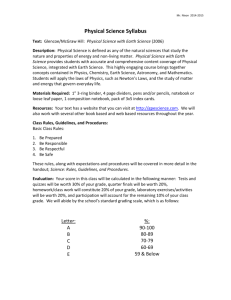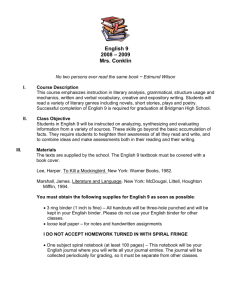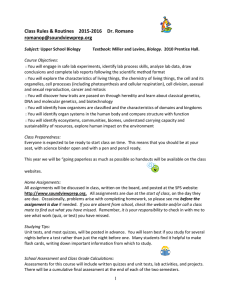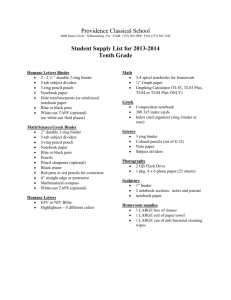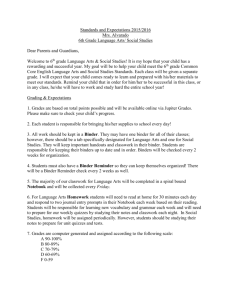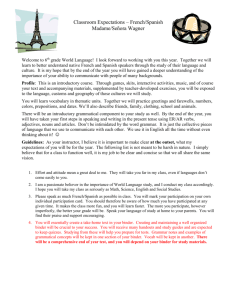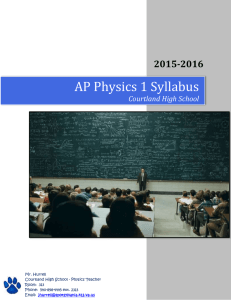AP Physics 2 Syllabus - Mr Hurrell's Classroom
advertisement
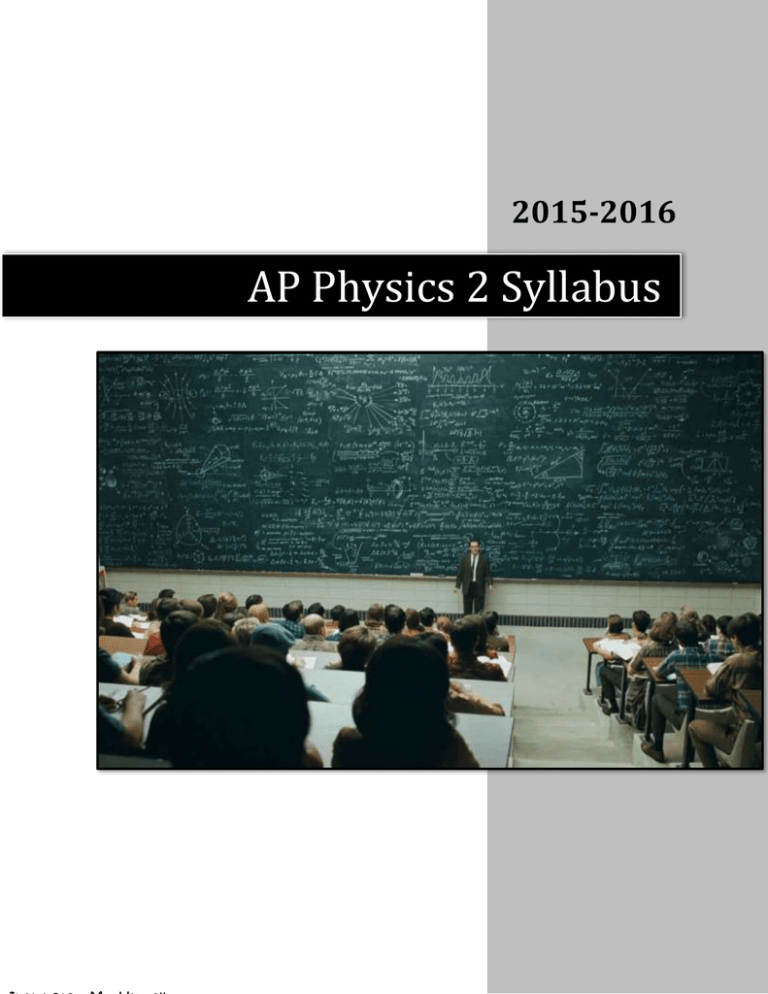
2015-2016 3 AP Physics 2 Syllabus Table of Contents Course Overview ........................................................................................................................................ 2-3 Prerequisites ............................................................................................................................................. 2 Description ................................................................................................................................................ 2 Required Materials ................................................................................................................................... 3 Grading Policy ............................................................................................................................................... 4 Grading Scale ............................................................................................................................................ 4 Grade Breakdown ..................................................................................................................................... 4 Homework..................................................................................................................................................... 5 Expectations .............................................................................................................................................. 5 Obtaining Help .......................................................................................................................................... 5 Lab Work ....................................................................................................................................................... 6 Lab Notebook ............................................................................................................................................ 6 Expectations ........................................................................................................................................... 6-7 Unit Descriptions...................................................................................................................................... 8-14 1 Course Overview Prerequisites Successful completion of AP Physics 1 will be required to assure success in this course. As with AP Physics 1, an appetite to better understand the scientific world around you will lay the foundation for another great year in the AP Physics classroom. As with AP Physics 1, Algebra and Trigonometry will be the mathematical tool’s used to support analytical examination of the many observations made by the student throughout the year. Description AP Physics 2 is the second year of a two year algebra based curriculum which covers all topics found in a typical college introductory physics course. AP Physics 2 will continue to develop the skills needed to succeed not only in physics, but in the college classroom where a relentless pursuit of excellence and a confident understanding of subject matter are a must. Experimentation, at home and in the lab, will foster observations that will be supported via physical models that the student will become familiar with during the year. Topics of study in AP Physics 2 will be: - Fluid statics and dynamics - Thermodynamics with kinetic theory - PV (Pressure Volume) diagrams and probability - Electrostatics - Electrical circuits with capacitors - Magnetic fields - Electromagnetism - Physical and geometric optics - Topics in modern physics Laboratory investigation focused on developing critical thinking and reasoning skills, along with traditional classroom work (i.e. quizzes & exams), and a regular dose of fun (aka homework), will be the primary assessment tool used during the year. 2 Required Materials Item Textbook 3” 3-ring binder + 7 dividers 1” 3-ring binder + 7 dividers Lab Notebook Calculator Other items Description Cutnell & Johnson's Physics: 9th Edition Large 3-ring binder with 7 sections labeled: - Class syllabus - Classroom Discussion & Activities (Not including labs) - Homework - Lab Reports - Quizzes - Exams - Completed quizzes from “Quiz Bank” This binder will contain material for the whole year and will be kept at home. Mr. Hurrell will ask students to bring this binder in once per month to check for completeness. Small 3-ring binder with 7 sections labeled: - Grade Sheet - Classroom Discussion & Activities (Not including labs) - Homework - Lab Reports - Quizzes - Exams - Completed quizzes from “Quiz Bank” This binder will contain material for the current unit and will be brought to class every day. Binder checks will be performed once per week. 9-3/4" x 7-1/2" 100 sheet Composition notebook Used by student in data collection activities for all “in class” and “at home” laboratory investigations One of the following scientific/graphing calculators: - TI-83, TI-83 Plus, TI-83 Plus Silver - TI-84 Plus, TI-84 Plus Silver, TI-84 Plus C Silver - TI-85 - TI-86 - TI-89, TI-89 Titanium - Several mechanical pencils - Several erasers - Several #2 pencils - Several black pens - Colored pencil set - Ruler Table 1: Required Materials for AP Physics 2 3 Grading Policy Grading Scale Grade Numerical Equivalent 98-100 93-97 90-92 87-89 83-86 80-82 77-79 73-76 70-72 67-69 63-66 60-62 59 and below A+ A AB+ B BC+ C CD+ D DF Points Awarded 4.3 4.0 3.7 3.3 3.0 2.7 2.3 2.0 1.7 1.3 1.0 0.7 0.0 Table 2: Grading Scale for AP Physics 2 Grade Breakdown Activity Homework % of grade 15 Classwork 10 Labs 30 Quizzes 10 Exams 35 Description Each homework assignment will be graded by Mr. Hurrell for, correctness, completeness, and timeliness. Late assignments will be accepted but the overall grade will be docked 25% for each calendar day late. Bell ringers, other classroom activities (excluding labs), and organizational skills (binder checks) will be assessed by Mr. Hurrell. Effort and correctness will be the primary concerns for these items. Laboratories will comprise a significant portion of the students learning experience (~25 %). Pre-lab activities, the data collection phase, and the analysis phase including the associated write-up, will be assessed by Mr. Hurrell. Quizzes will be comprised of free response questions that closely resemble questions available to students in the online quiz bank. Students will be provided with a formula sheet (including appropriate constants) during the quizzes. Exams will be comprised of free response and multiple choice questions, which closely resemble quiz bank questions and the new College Board AP Physics 1 & 2 test design. Students will be provided with a formula sheet (including appropriate constants) during the exams. Table 3: Grading Breakdown for AP Physics 2 4 Homework Expectations Homework is the student’s opportunity to exercise concepts covered in the classroom and/or laboratory. So Mr. Hurrell can assess your understanding of the concepts please show all work. Homework feedback provided by Mr. Hurrell and student follow-up are critical components of homework. On the homework due date (Day after it’s assigned): - Place completed HW in your classes INBOX at the beginning of the class period - Make sure your name is on each piece of paper - If you have more than one piece of paper staple the pieces together - Pickup corrected HW from your classes OUTBOX which will be available the day after you turn it in - Place corrected HW in your binder Obtaining Help By appointment, Mr. Hurrell will be available before and after school for any student requiring assistance with their homework. If prior arrangements are made, Mr. Hurrell will also be available during his lunch time or planning period. 5 Lab Work Lab Notebook Students will record all laboratory investigations in their “Lab Notebook”, a 9-3/4" x 7-1/2" 100 sheet Composition notebook using a pen. Incorrect entries can be noted as such with an accompanying reason, but regardless of the reason they will become part of the permanent record. Typical entries in the Lab Notebook will be: - Lab Title - Lab Overview - Date of laboratory observations - Laboratory observations (aka data collection) - Observation notes Expectations Laboratory investigations will be used to stimulate student engagement with the physical world in a team based environment. Experimentation, making initial expectations and arguments, analyzing observations, problems solving, and presentation of these elements in an organized report, will be some of the skills exercised and sharpened in the Physics lab. Students will be expected to actively participate with other team members during all phases of each investigation and team members will be determined by Mr. Hurrell. 6 A typical lab investigation and report will be comprised of the following elements and the following rubric will be used to assess the student performance: Element Contents Pre-lab Report Pre-lab Typically one page long and should contain your thoughts regarding: investigation - Physical phenomena that will be investigated - Everyday instances where the physical phenomena can be observed (Provide at least three examples) - Short summary of procedure that will be used in the investigation - List of Physics models that apply to the investigation - Expected observations (How close will they be to the physics models) Lab Report Top-level - Informative title Information - Date - Your Name - Lab partners names Lab Overview - Physical phenomena investigated - Everyday instances where the physical phenomena can be observed - Goal of the lab - Summary of the results of the investigation Description of - Step-by-step description of procedure Procedure Note: Include sufficient detail so investigation can be repeated by someone not in the class o Apparatus used (Include picture if needed) o Measuring devices used Data Collection - List all data collected and observations - List any qualitative observations that are used to support conclusions Physical models - List all physical models (aka formulas) used to examine the data used (Calculations) - Make sure to include appropriate units Tabulate and - Summarize all data collected in the appropriate format(s) (i.e. table, Graph to present graph) data and/or - Table headers should be properly labeled, including correct units, findings and a proper caption included below table - Graph’s should be properly labeled, including correct units, and a caption should be included below the graph. Examine sources - Discuss sources of error during the data collection phase of error (Measuring device errors, apparatus induced errors, etc. …) - State how the sources of error impacted your results Conclusion - Discuss your results and compare your real-world observations to theoretical physical model’s - Discuss what you learned and what you might do differently if you repeated the investigation Total 7 PTS 10 5 10 15 10 15 10 10 15 100 Unit Descriptions Unit 1: Fluids Topics Covered - - Mass Density Pressure o Depth in static fluid o Gauges Pascal’s Principle Archimedes’ Principle Fluid Dynamics o Equation of continuity o Bernoulli’s principle o Viscous flow Questions to ponder - Coming soon Unit 2: Temperature & Heat Topics Covered - - - Temperature Scales Thermal expansion o Linear o Volume Heat & Internal Energy Heat & Change o Specific Heat o Latent Heat o Calorimetry Heat Transfer o Conduction o Convection o Radiation Questions to ponder - Coming soon 8 Unit 3: Ideal Gas Law & PV Diagrams Topics Covered - Molecular Mass & Mole Ideal Gas Law Kinetic Theory PV diagrams and probability - Coming soon Questions to ponder Unit 4: Thermodynamics Topics Covered - - Systems & surroundings First law of thermodynamics o Thermal processes o Specific heat capacities Second law of thermodynamics o Heat engine o Carnot engine o Entropy Third law of thermodynamics - Coming soon - Questions to ponder 9 Unit 5: Electrostatics Topics Covered - Conductors and Insulators Charging by Contact & Induction Coulomb’s Law Electric Field - Coming soon Questions to ponder Unit 6: Electrical Circuits with Capacitors Topics Covered - - Capacitors o Characteristics o Series circuits o Parallel circuits RC circuits - Coming soon Questions to ponder 10 Unit 7: Magnetic Forces & Fields - - - Topics Covered Magnetic fields o Force on a moving charge o Motion of a charged particle Current in a magnetic field o Force o Torque Fields produced by currents Ampere’s law Questions to ponder Coming soon Unit 8: Electromagnetic Induction Topics Covered - - - Magnetic fields Induced EMF & current o Motional EMF o Magnetic flux Faraday’s law Lenz’s law Inductance o Mutual o Self Transformers Questions to ponder - Coming soon 11 Unit 9: Electromagnetic Waves Topics Covered - - The nature of EM waves EM spectrum EM waves o Energy o Doppler effect The speed of light Polarization - Coming soon Questions to ponder Unit 10: Geometric Optics Topics Covered - - - - - Reflection: Mirrors o Reflection o Plane mirror o Spherical mirror o Mirror & magnification equation Refraction: Lenses o Index of refraction o Snell’s Law o Total internal reflection o Polarization o Dispersion Lenses o Image formation o Thin lens equation o Lens systems Optical devices o Human eye o Telescope o Compound microscope o Lens aberrations Questions to ponder Coming soon 12 Unit 11: Physical Optics Topics Covered - - Linear superposition o Thin-film interference o Double-Slit interference o Interferometer Diffraction o Resolving power o Grating o X-ray Questions to ponder - Coming soon 13 Unit 12: Topics in Modern Physics - - - - - Topics Covered Particles & Waves o Wave-particle duality o Blackbody radiation & Planck’s constant o Photons Photoelectric effect Momentum Compton effect o DeBroglie wavelength Nature of the Atom o Rutherford scattering o Bohr model o Quantum mechanics of hydrogen Nuclear Physics o Nuclear structure Nuclear force Binding energy Stability of the nucleus o Radioactivity Decay & activity Decay series Nuclear Energy o Nuclear Reactions A. Fission B. Reactors C. Fusion o Elementary particles o Ionizing radiation Questions to ponder Coming soon 14
